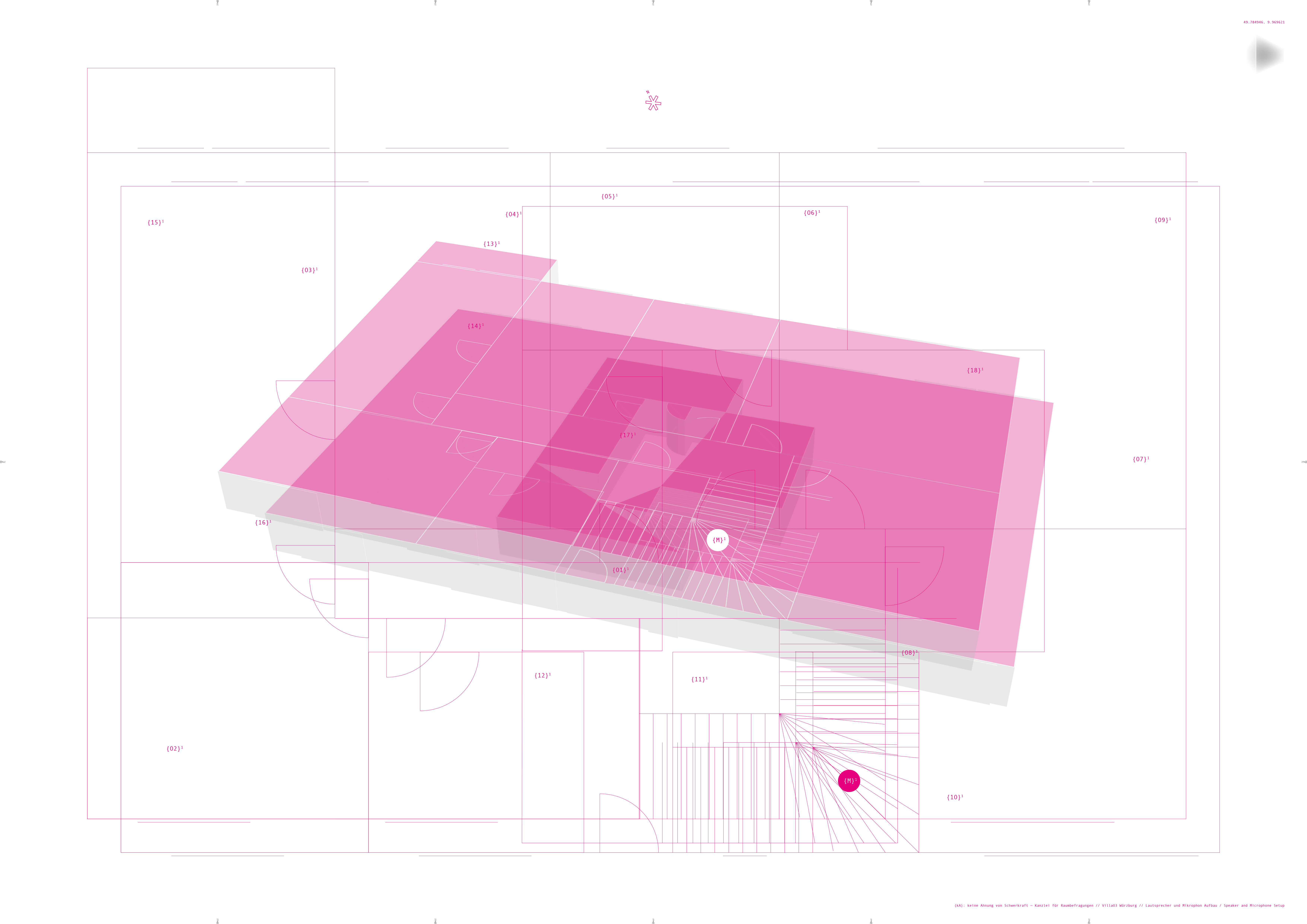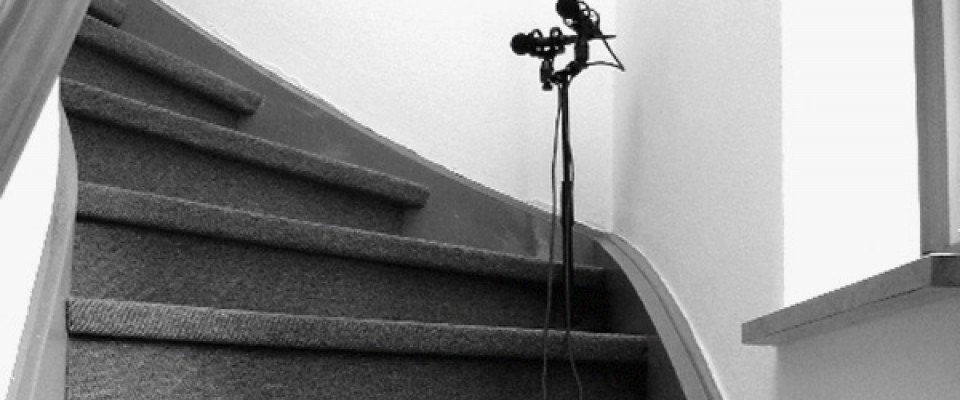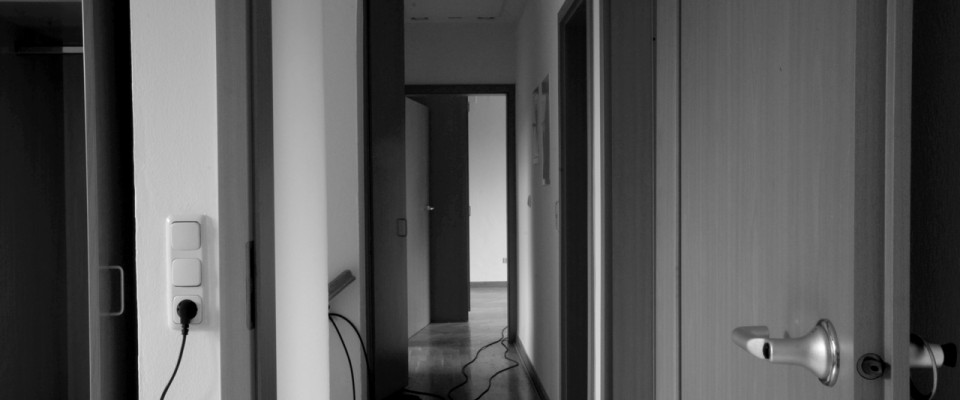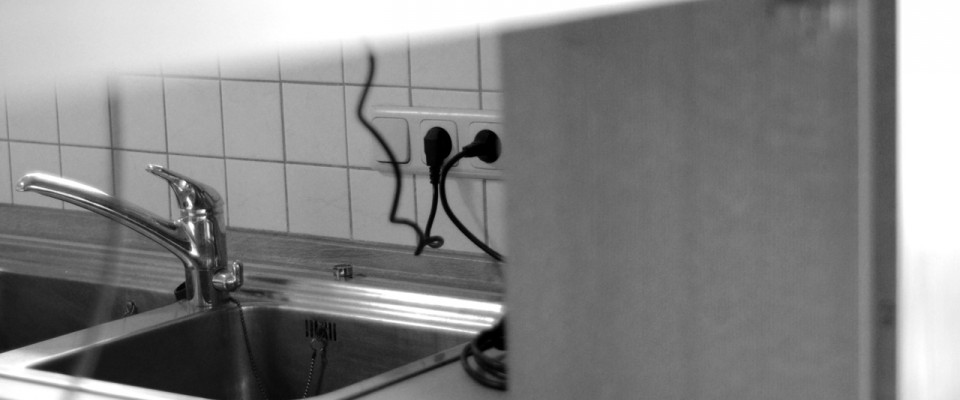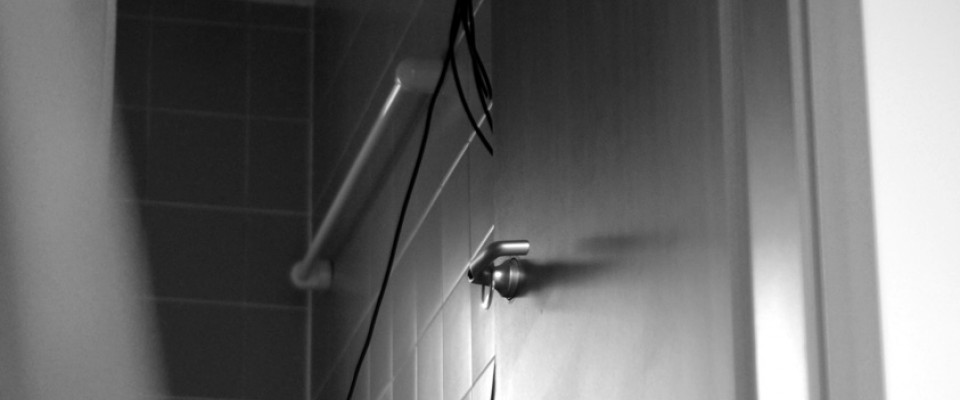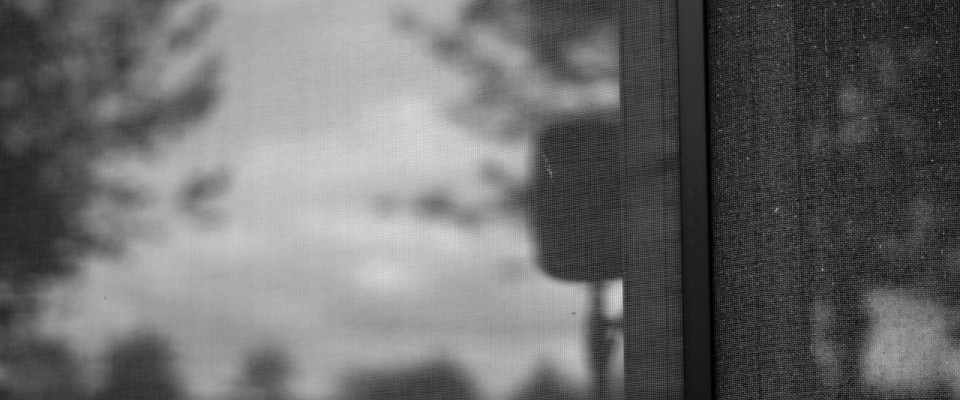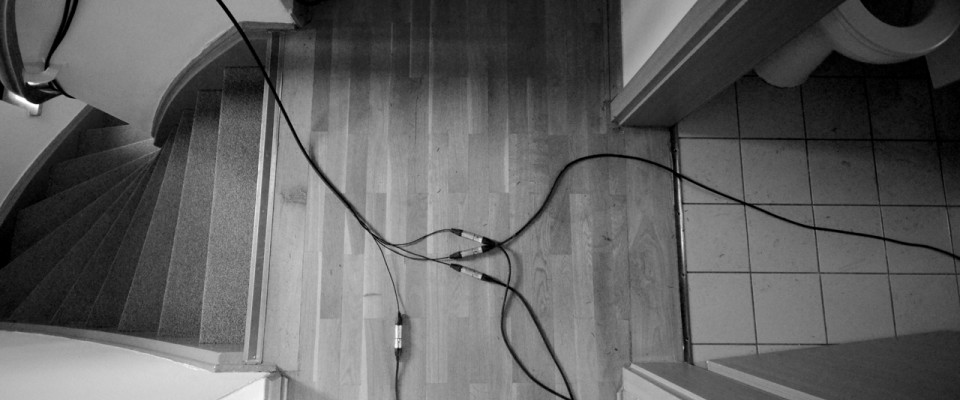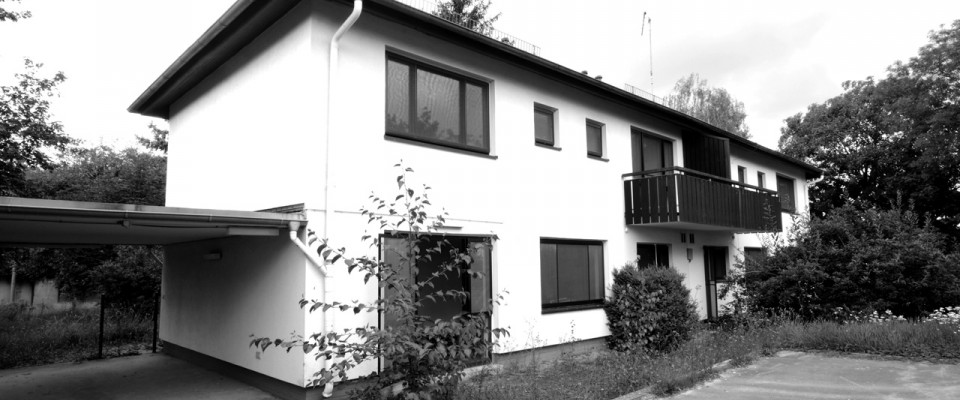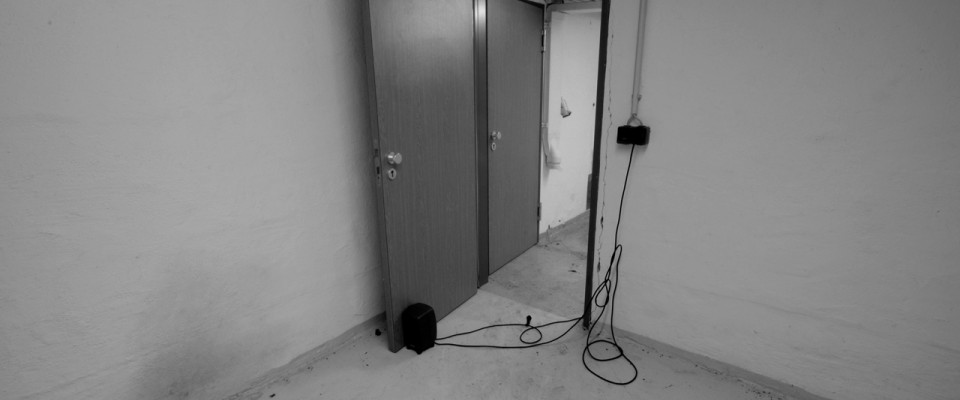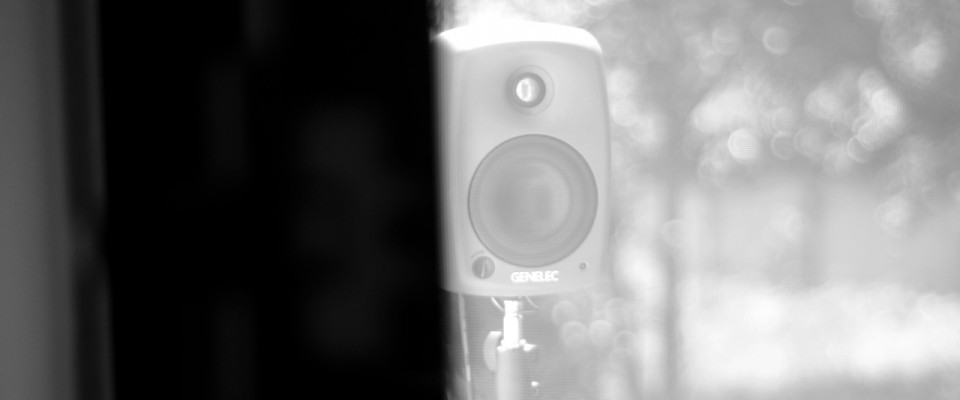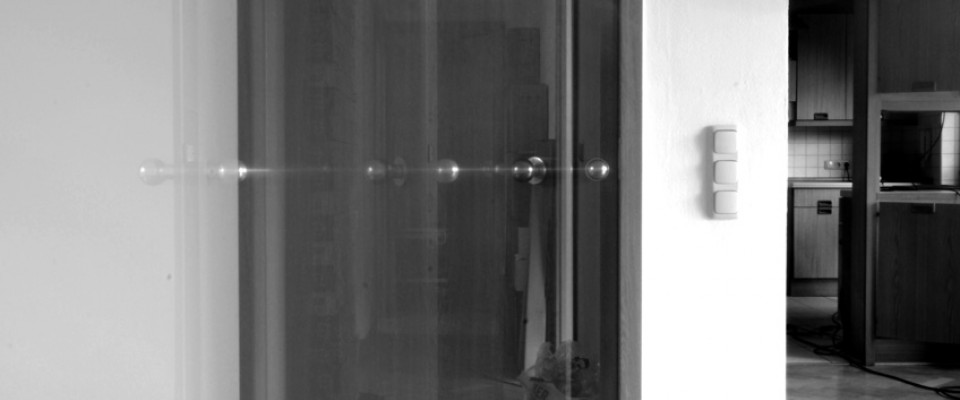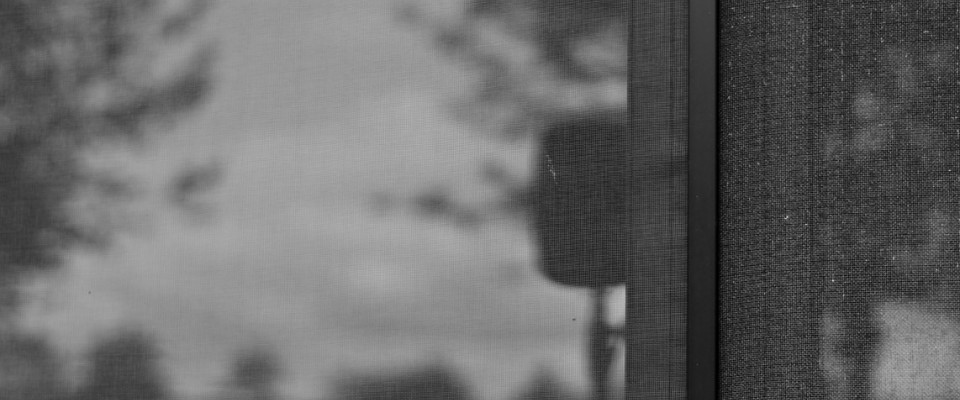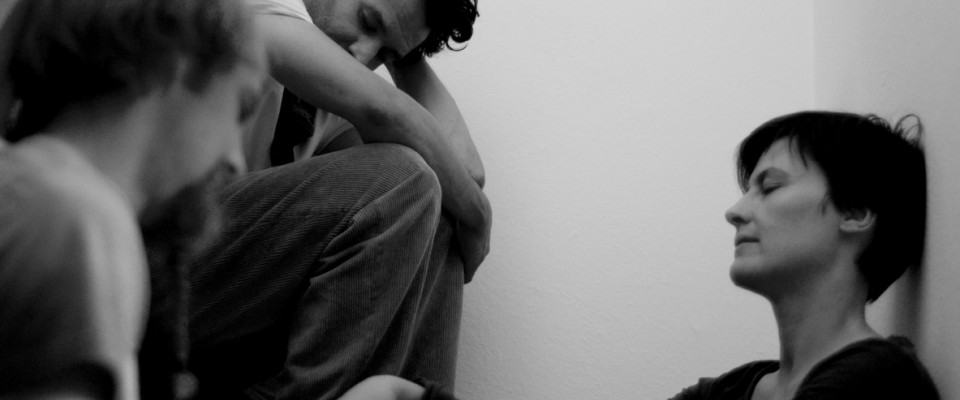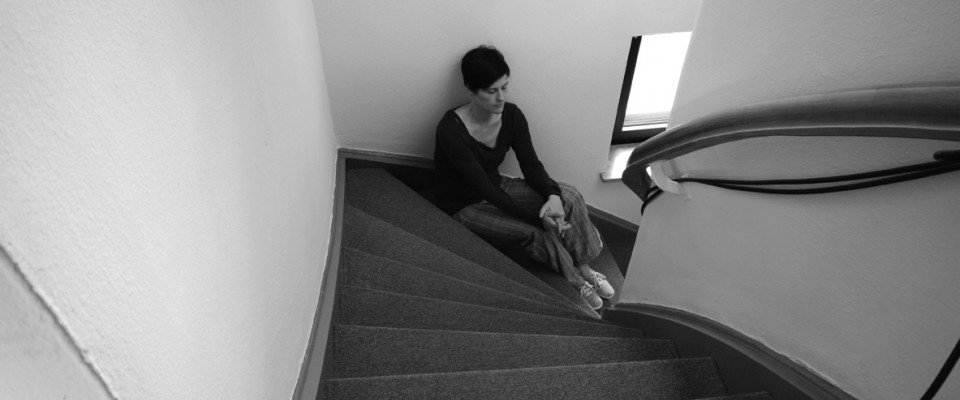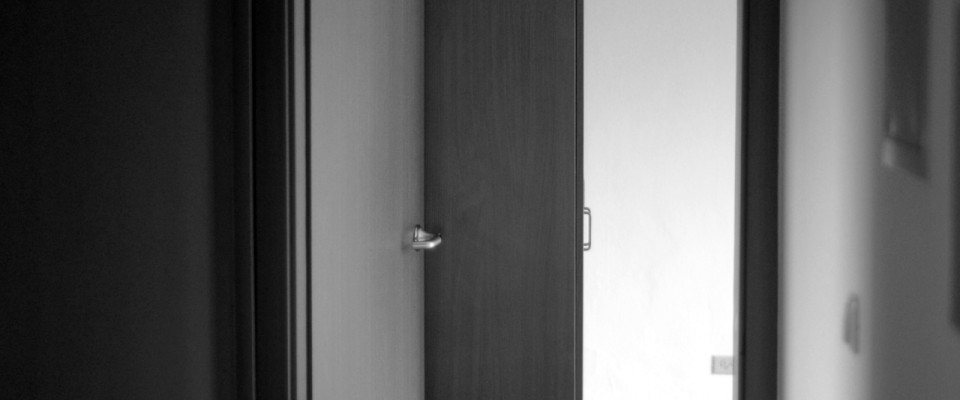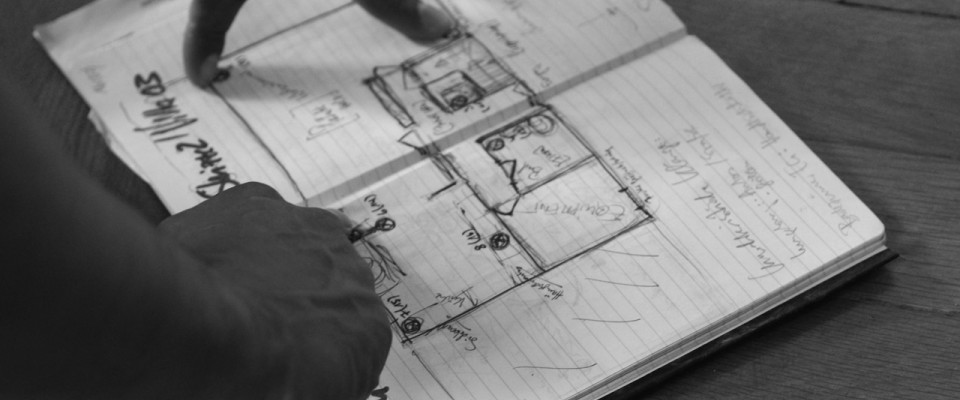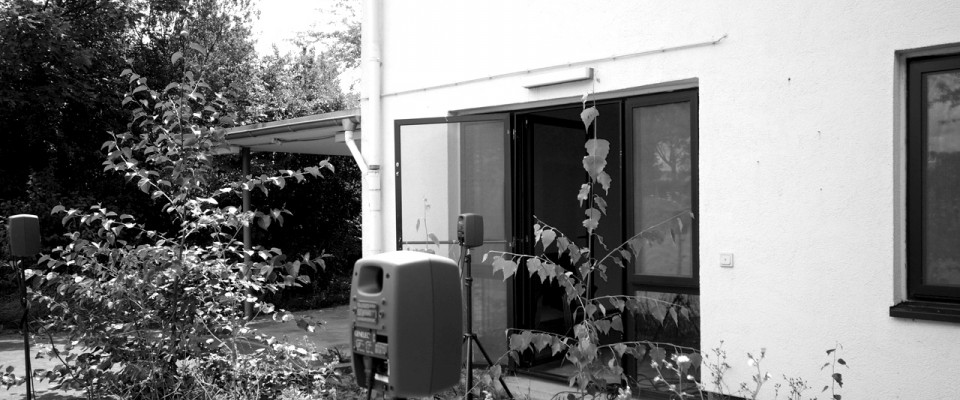{ INSIDE THE BUILDING }
At first, using the Hubland building sounded like a good idea; the building was unoccupied, easy to reach, relatively simple, and small construction with two stories located in a historical area. I would have never guessed the questions and puzzles that the building would pose and the doubt that would torture me over the weeks working there.
I sit and listen but there does not seem to be much to hear.
Within a half-hour, I note the sound of crickets chirping, of water running, (which, I would soon learn, starts every day at 12 o’clock, as if turned on by an invisible hand), wind and rustling in different colourings and intensities, and a fly, which occasionally flies against the window. And now and then there are different volumes of sound from the cars, which escape from beyond the noise barrier and penetrate, break, and become part of the acoustic panorama in the left and/or right pattern.
I walk around the building, sit on the floor in the hall, sit inside a closet for a while and I walk out to the old, rickety balcony upon which moss now grows. I open doors, close doors, tilt the window. All of the windows have screens, but they can only be heard when the wind rattles their aluminium framing. I linger in the kitchen for half an hour. When I open my eyes and walk into the living room, there is a dull and quiet hissing sound. I open all the screens and listen to the sound of the wind blowing through them. It isn’t much, but it is the information I have to collect.
I record the empty rooms, take note of times, and takes. Not too much – listening must be done in real time. In the evening, I go to my hostel and get to know the microphone’s perspective by 'reviewing' the recordings. What sounds are on the recordings that I overheard? Why did I overhear them? I also compare it to my own perspective and ask myself if anything is missing from the recordings that I remember hearing. And then an old realization comes to mind: that concentrated listening is only possible for short periods of time. After that, one starts to imagine things. A fascinating point, but one has to come up with ways to get around it.
Going up and down the stairs, I always pass a corner of the carpeted steps. When going up the stairs, and when descending, one approaches a wall before turning down a hall. At the end of the second week, while sitting on a bus into town, it occurs to me that when I turn at that particular spot and stand in the corner, I hear more downward with my left ear, and on my right ear, I hear more from upstairs. Very basic. The next morning, I sit on the spot in the corner of the stairs. I have found my listening spot.
The building and the sound of its rooms become more and more familiar to me over the passing weeks. My perception becomes more sensitive to the building’s atmospheres, which, due to the design, are very similar and have something uniform about them. Although I am occasionally startled by passers-by who tap on the screens and ask if the object can be rented, and thus rip me out of my concentration (in such moments I perceive them as sinister intruders), on the whole, the atmosphere of the building starts to become tangible.
Being alone here has a whole other dimension than being alone in the studio. When the studio is empty, the speakers stare at me expectantly and menacingly (as if shouting: 'make some sound!'). But the room here is always dense and “threatened” by outside conditions, I realize as I stare at the hallways, the walls, and the ceiling. In the studio, I feel like I am on an isolated island. But here, it feels like floating on a raft and being at the mercy of the turbulent waters of the surrounding medium. {…}
{ HISTORY }
The first building used in the series {kA} :Oblivious to Gravity is Villa03, a house previously used by the US military at the Leighton Barracks in Wurzburg, Germany.
The 135-hectare compound was run by US forces from 1945 to 2008 and consists of a good dozen apartment buildings, single-family homes, schools, sports facilities, and an American-style shopping centre with base exchange stores.
After the withdrawal of the 1st Infantry Division from Wurzburg in 2008, the compound was handed over to the German government. In 2009, the German state of Bavaria bought 39 hectares of the Leighton Compound to expand the University of Wurzburg (Campus Hubland).
Villa03 is a semi-detached civilian house that was built in the 1970s; it was most likely inhabited by an officer and his family during the occupation. The two-story home was built with a basement, an attic, a carport, two terraces, and a garden.
The ground floor consists of a front room, a storeroom, a guest restroom, a combined family and dining room, a kitchen with a service hatch, and an office. The second floor, which can be accessed by a winding staircase, has four bedrooms and a bathroom. In the basement, there are washrooms and storerooms and also a furnace room. {…}
{...}
{...}
{ MATERIAL }
I fix contact microphones to the windows of Villa03 and record in the mornings and at night. I filter and save the material, amplify frequencies, and play the sounds back at different parts of the building. I collect and write down information – reactions, interactions, and intersections and try to replicate them.
For example, the speakers in the basement, especially the one in the washbasin, create vibrations with low frequencies around 80 Hertz in parts of the foundation that are transferred to the wood in the stairwell and the coatroom. The vibrations make sounds and can be intensified; its rhythm can be centrally controlled. I record the “empty” rooms, playback the signals, and create feedback, in order to stir up the room and provoke a reaction, which I also record as material.
I try to find an electro-acoustic equivalent to the sound made by crickets; using a random generator I play little bursts of electronic chirping with varying densities. I also use differently tuned sinus generators directed towards the rooms so that I can hear moods colored by the different rooms at my listening point and then I attempt to modulate and compose them. To my back, noise penetrates the building through the noise barrier outside, through the bushes, and the building’s outer wall.
The street becomes an important point of reference for all further considerations. The volumes, frequencies, and movements within the building; all sound constellations, which have already been made and which have yet to be created should all be put in relation to this point.
This is the third week’s work, day in, day out, for as long as I can concentrate and as long as my ears 'play along'. {…}
The relationship between music and space is evident; it has shaped the history and the aesthetics of music, albeit in different ways. Spaces, for example, rooms, have physical properties that affect the way sounds created within them resonate and also influence their acoustical structure. {…}
Music is dependent upon certain acoustic characteristics of the room in which it is played. The room's acoustics can have an amplifying or a dulling effect on the music. A room's architectural structure must therefore meet certain quality standards in terms of spatial acoustics in order to optimize sound. That is why to this day, the construction of concert halls continues to be a tremendous task.
Depending on the perspective, spatial acoustics can work in two ways; on the one hand, it affects what we hear because it changes the sound of tones. Anyone who has been to a concert in a church (where there is a big echo) or outdoors, where the sounds seem to 'disseminate' has experienced this effect.
But there is another perspective which has the reverse direction, sound makes geometry audible: »We hear the emptiness of an uninhabited house, the depth of a cave, the nearness of a low-hanging ceiling, the refinement of an office with expensive carpets, and the density of a city with cavernous avenues.«[1] Barry Blesser and Linda-Ruth Salter are referring here to »sonic illumination«.
A room, as an architectonic structure, has certain acoustic properties that themselves become audible through sounds. Blesser/Salter compare this phenomenon to optical illumination: »Just as light illuminates objects and geometries to provide a visual experience of them, sound illuminates objects and geometries to give them an audible manifestation.«[2]
For a room to be heard, there needs to be a listener with »human experience« (Blesser/Salter), and »corporal presence«(leibliche Anwesenheit, Böhme): »This is the space we experience through our corporal presence – the space we feel corporally, first-hand. This space is generally defined by the proximity between objects or walls, i.e. how close or far apart they are from each other. It is […] not a homogenous or anisotropic space, i.e., it is centred, namely defined by the absolute here and now of my presence.[…]«[3]
The spatial concept which Böhme describes is neither a mathematical concept of distance and spacing between objects (spatium), nor a topographical concept determined by relationships to surrounding objects (topos). Instead, he concentrates on the corporal (leiblich) presence of the person, or listener, who perceives the space.
Blesser and Salter, who describe the concept of 'aural architecture', also place emphasis on the human perspective of space and the sounds created within it. They also see a person’s sensory perception of space as a basic requirement.
'Aural architecture', as described by Blesser and Salter, »is the composite of those spatial properties that have an audible manifestation. Spatial acoustics produces dozens of audible cues that can be detected, decoded, and interpreted, and when listeners attend to those cues, they are engaging in auditory spatial awareness.«[4]
While the 'acoustic' architecture describes the properties of a room in a scientific, i.e. measurable, form of sonic physics, 'aural' architecture is concerned with the perception of the sound occurrences of a room. It is about experiencing space through careful listening.
How does space sound?
This is where Oblivious to Gravity comes in – in the study of the acoustic possibilities of aural architecture. The engagement with the acoustic arena and the subsequent compositions hope to challenge audiences to fine-tune their listening capacities to sounds that surround us and to our surroundings, which are barely audible.
{ Literature }
[1] Barry Blesser and Linda-Ruth Salter: ›Aural Architecture‹, 2008, in: ›TunedCity. Zwischen Klang- und Raumspekulation‹, edited by Doris Klein, Anne Kockelkorn, Gesine Pagels and Carsten Stabenow, Idstein: Kookbooks, p.108.
[2] ibid.
[3] Böhme (2006): ›Architektur und Atmosphäre‹, p.88.
[4] Blesser/Salter (2008): ›Aural Architecture‹, p.108.
